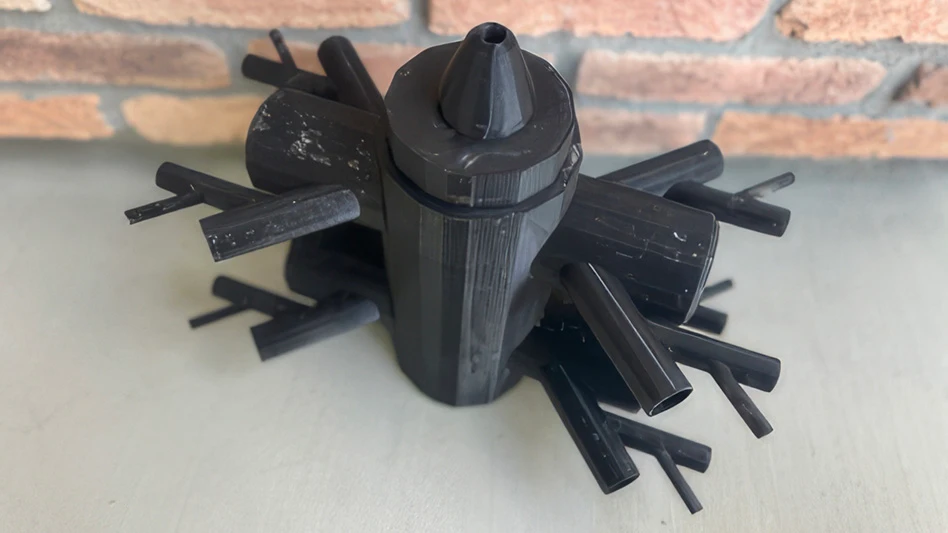
Photo courtesy of Kennesha Garg
Kennesha Garg, a junior at American High School in Fremont, California, has designed a new landfill gas (LFG) pipe, which she says she hopes to test this summer in a windrow at a compost facility.
For her efforts thus far, she won first place in San Francisco University’s 2023 Junior Science and Humanities Symposium in the Environmental Science category.
Garg says she spent some of her childhood in India living in areas with dumps nearby.
“Where my parents and I lived, there were pockets of dumps everywhere,” she says. “This always used to bother me because of how it used to basically tarnish the beauty of the place that I loved the most. And, also, it really affected my health and my family’s health.”
RELATED: LFG Recovery: A road map to success | Fort Worth, Texas, considers installing LFG collection system
As a young child, she says she wondered why waste wasn’t managed better and learned in high school about the role methane and carbon dioxide emissions from landfills play in climate change.
“I resolved to tackle the situation because it was so close to my heart,” she says. “I have to do something about this because of how it has affected me and my family personally, and how it has affected so many other people in the world.”
Inspired by the roots of mangrove trees and the idea of biomimicry, Garg says she set about trying to design LFG collection pipe system that uses a root structure to access more landfill area than standard pipes.
“When I discovered mangroves, I realized that they were a perfect fit for my design because a lot of mangroves actually have roots that are underwater,” she explains. “These roots, they don’t get much oxygen, but the mangrove kind of developed a system where it’s able to transfer oxygen by taking oxygen from the leaves and then it uses some pressurized tissues to transmit this oxygen into these roots.”
She says this is similar to the way LFG collection systems need to vacuum out methane and carbon dioxide.
“The suction element is pretty similar to the suction systems in current landfills where they use these vacuum pumps to extract out the methane, and then all this methane and carbon dioxide is sent off to a facility to be converted into renewable energy,” she says. “But it’s the shape of the piping itself that is what I was trying to tackle because it is very inefficient in current landfills.”
While she’s hoping to test different pipe shapes and materials this summer at a compost facility, Garg says she has gathered some data. She created two landfill systems in her backyard, one designed similarly to traditional LFG collection systems and the other using her 3D-printed prototype which she designed on CAD software.

a root-inspired LFG collection tube in compost. She also
had a control container with a traditional LFG collection tube.
“I added compostable waste to both of these and then completely sealed them so there was no oxygen that was able to enter either of these,” she said.
Testing for pressure, the temperature of the compostable material and methane concentration in the sealed compost containers, Garg says the root pipe prototype was able to extract 91 percent of the gases generated in the compost bin compared with 54 percent using the traditional LFG pipe structure.
She says she’s still researching the material used in the root pipe but is considering using high-density polyethylene, which is a material used in landfills. She says she hopes to learn more about what specific type of root structure is most efficient for collecting gas this summer.
“There’s obviously a long way to go before this is actually implemented in landfills, but I’m planning on continuing this project in my undergrad and graduation education, so it’s going to be something that stays with me for a long time," Garg says.
She’s also reached out to landfill experts to get feedback on her idea and plans to reach out to them again after she collects data from a larger-scale experiment at a compost facility.
If her results continue to show promise, Garg says she hopes to introduce more variables into her experiments.
Mooring Advisory Group, a Boston-based public relations firm that works with venture-backed tech startups, is working to help her spread the word about her project.
Latest from Waste Today
- Viably, Turmec partner on Ohio installation
- EPA plans to revisit numerous environmental, climate regulations
- Miami-Dade Innovation Authority launches fifth Public Innovation Challenge
- Fornnax wins Green Innovation of the Year award
- Louisiana city launches glass recycling program
- City eWaste, Williamson County, Tennessee, offer electronics recycling stations
- Casella commits $1.5M to launch circular economy center at the University of Vermont
- Mavitec Green Energy expands in US market





